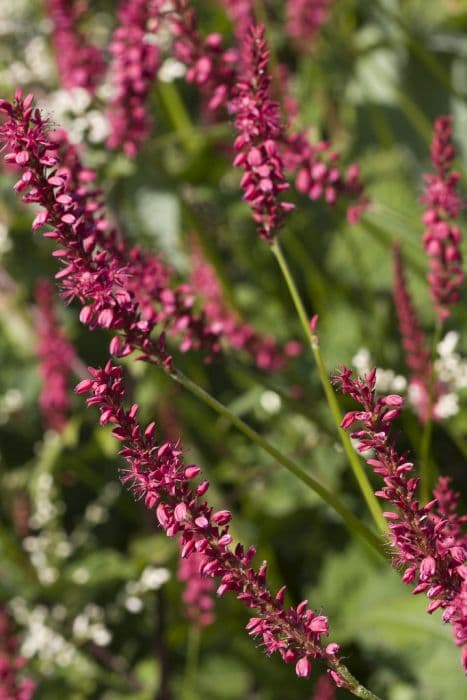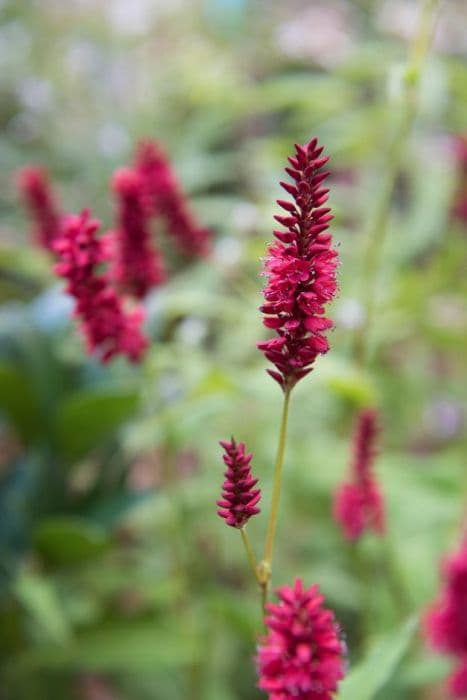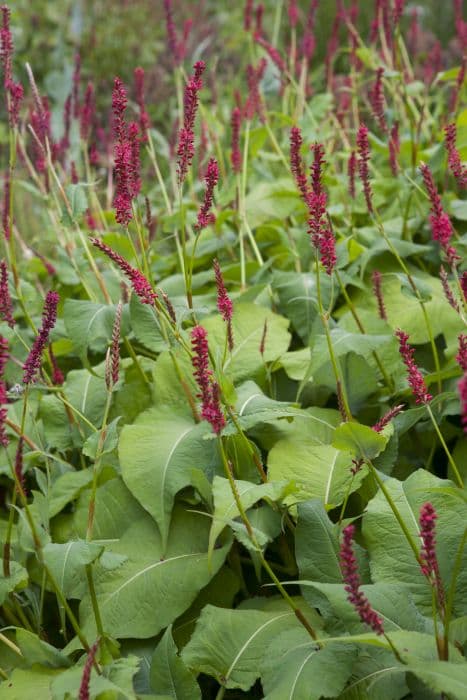Painter's Palette Persicaria virginiana (Variegated Group) 'Painter's Palette' (v)

ABOUT
Painter's Palette is an eye-catching perennial known for its highly decorative leaves. The foliage is the main attraction, featuring an artistic blend of colors. Each heart-shaped leaf boasts a creamy-white to pale yellow variegation along the center, resembling a painter’s work of dappled light. This central splash is bordered by a rich green, adding contrast and emphasizing the variegated pattern. In some cases, a dramatic chevron pattern of dark maroon to brown streaks can cut across the leaf, completing the palette of hues. Adding to its appeal, tiny beads of flowers may appear on slender, arching stems, rising above the colorful tapestry of leaves. These flowers are often a delicate shade of red or pink, complementing the leaves without overshadowing them. The overall effect of Painter's Palette is one of a vibrant, colorful groundcover or accent plant that brings artistic flair to any garden space it occupies.
About this plant
 Names
NamesFamily
Polygonaceae
Synonyms
Painter's Palette, Variegated Jumpseed, Virginia Knotweed
Common names
Tovara virginiana, Polygonum virginianum, Persicaria filiformis.
 Toxicity
ToxicityTo humans
Painter's Palette is not listed as a hazardous plant, and there is no well-documented evidence of its toxicity to humans. Therefore, ingesting parts of the Painter's Palette is not generally regarded as poisonous and should not cause symptoms of poisoning under normal circumstances. However, as with many plants, sensitivity varies from person to person, and it's always prudent to err on the side of caution and avoid ingesting plant material that is not commonly used for food.
To pets
Painter's Palette is generally not considered toxic to pets. There is limited information available on its toxicity, but it is not listed among commonly poisonous plants for pets. Nevertheless, ingestion of plant material by animals can sometimes lead to gastrointestinal upset or allergic reactions. It is advisable to monitor pets around plants and discourage them from chewing on ornamental foliage to prevent any potential digestive issues.
 Characteristics
CharacteristicsLife cycle
Perennials
Foliage type
Deciduous
Color of leaves
Mixed
Flower color
Pink
Height
2 feet (60 cm)
Spread
1.5 feet (45 cm)
Plant type
Herb
Hardiness zones
4-8
Native area
North America
Benefits
 General Benefits
General Benefits- Aesthetic Appeal: 'Painter's Palette' adds visual interest to gardens with its unique variegated foliage featuring a blend of green, cream, and pink hues alongside a distinctive burgundy chevron.
- Wildlife Attraction: The plant produces small, inconspicuous flowers that can attract butterflies and other beneficial pollinators, supporting local biodiversity.
- Drought Tolerance: Once established, 'Painter's Palette' has good drought tolerance, making it suitable for gardens with less frequent watering.
- Easy Propagation: It can be easily propagated by division or self-seeds in suitable growing conditions, making it an economical addition to the garden.
- Shade Tolerance: This plant can thrive in a variety of light conditions, including shaded areas where other plants may struggle.
- Soil Versatility: 'Painter's Palette' adapts to a range of soil types, though it prefers well-draining, fertile soil.
- Fast Growth: It has a relatively fast growth rate, allowing for quick filling in of garden spaces or restoration of disturbed sites.
- Deer Resistance: The plant is not a preferred food source for deer, making it a good choice for areas with high deer populations.
- Multipurpose Use: Suitable for use in borders, woodland gardens, and cottage gardens, 'Painter's Palette' offers versatility in landscape design.
 Medical Properties
Medical PropertiesThis plant is not used for medical purposes.
 Air-purifying Qualities
Air-purifying QualitiesThis plant is not specifically known for air purifying qualities.
 Other Uses
Other Uses- 'Painter's Palette' offers a habitat for butterflies and bees, serving as a focal point in pollinator-friendly gardens.
- Due to its colorful foliage, it can be used as a natural dye for fabrics and textiles, providing a variety of hues.
- This plant is sometimes used in educational settings to teach about plant variegation and patterns of leaf coloration.
- The plant's striking appearance makes it ideal for use in floristry, particularly in creating artistic and unconventional floral arrangements.
- It can be incorporated into mixed container plantings, adding a splash of color and interesting texture among more traditional bedding plants.
- The plant's vigorous growth can be utilized to quickly fill in barren spots in gardens, providing a lush and colorful ground cover.
- It serves as an excellent backdrop plant for garden photography, contrasting well with flowers and other greenery.
- Dried leaves of 'Painter's Palette' can be used in crafts, such as bookmarks or in decoupage projects.
- In theme gardens, like an artist's garden, 'Painter's Palette' exemplifies the creative use of foliage for visual impact.
- Its dense foliage can be used as a privacy screen in smaller garden settings or urban spaces.
Interesting Facts
 Feng Shui
Feng ShuiThe Painter's Palette is not used in Feng Shui practice.
 Zodiac Sign Compitability
Zodiac Sign CompitabilityThe Painter's Palette is not used in astrology practice.
 Plant Symbolism
Plant Symbolism- Creativity: 'Painter's Palette' suggests a connection to artistry and the creative process due to its variegated foliage resembling an artist's palette.
- Diversity: The different colors on its leaves symbolize diversity, acceptance, and harmony in varied aspects of life.
- Balance: This plant can symbolize the balance between different forces and ideas, as it beautifully combines varied hues within a single leaf.
- Adaptability: Persicaria virginiana is a versatile plant that can grow in various conditions, symbolizing adaptability and resilience.
 Water
WaterFor 'Painter's Palette' watering should be consistent to keep the soil moist but not waterlogged. Water the plant thoroughly when the top inch of soil feels dry to the touch, which may be once or twice a week depending on the climate and indoor conditions. Apply water directly to the base of the plant until you see excess water begin to drain from the bottom of the pot. This usually amounts to roughly 16 to 32 ounces for a medium-sized pot every week, but always adjust according to the plant's needs and seasonal changes in temperature and humidity.
 Light
Light'Painter's Palette' thrives best in bright, indirect light. A spot near an east-facing window or a few feet away from a south or west-facing window where it can receive some gentle morning or late afternoon sun is ideal. Avoid placing it in direct, harsh sunlight as this could scorch the delicate leaves.
 Temperature
Temperature'Painter's Palette' prefers a temperature range between 60°F and 75°F. Protect the plant from temperatures dropping below 50°F, as it can start to suffer from cold stress. Conversely, extreme heat above 85°F can be detrimental to the plant's health. A stable indoor environment or a sheltered outdoor space that sits within this ideal temperature range is perfect.
 Pruning
PruningPrune 'Painter's Palette' to encourage a bushier growth habit and to remove any damaged or spent foliage. Pruning is best done in the spring or early summer when the plant is actively growing. Cut back the stems to just above a leaf node and ensure to use clean, sharp shears. Doing this once a season is typically sufficient.
 Cleaning
CleaningAs needed
 Soil
SoilPainter's Palette prefers a well-draining, fertile soil with a high organic matter content. An ideal mix could be equal parts garden soil, compost, and perlite or coarse sand to ensure good drainage. This plant thrives in slightly acidic to neutral pH, ranging from 5.5 to 7.0.
 Repotting
RepottingPainter's Palette does not typically require frequent repotting and can be done every 2-3 years. It's best to repot in spring if the plant has outgrown its container or the soil looks exhausted.
 Humidity & Misting
Humidity & MistingPainter's Palette thrives in moderate to high humidity levels. It can do well in typical household humidity but appreciates increased humidity, especially during dry winter months.
 Suitable locations
Suitable locationsIndoor
Keep in bright, indirect light and maintain moderate humidity.
Outdoor
Plant in part shade to full sun and well-draining soil.
Hardiness zone
4-8 USDA
 Life cycle
Life cycle'Painter's Palette' begins its life as a seed, which germinates in the spring when soil temperatures warm up. The seedling emerges and develops into a mature plant with characteristic variegated foliage and arching stems. Throughout the growing season, the plant undergoes vegetative growth, producing its distinct leaves and branching structure. In late summer to early autumn, small red or white flowers appear, which can produce seeds for the next generation if pollination occurs. After flowering, as temperatures drop in the fall, 'Painter's Palette' enters a period of dormancy, and the above-ground parts of the plant die back. In the spring, the plant regrows from the root system or new seeds, thus repeating its life cycle.
 Propogation
PropogationPropogation time
Spring to Summer
Propogation: Painter's Palette is commonly propagated by division, ideally in the spring. This allows the plant to establish in cooler temperatures before the heat of summer kicks in. To propagate by division, carefully dig around the plant to lift it from the ground while minimizing root damage. Then, using a sharp shovel or knife, divide the clump into smaller sections, ensuring that each division has a good amount of roots and shoots. These new plantlets can then be replanted immediately in well-prepared soil, spaced about 18 inches (approximately 45 centimeters) apart to give them room to grow. Water them thoroughly after planting to help establish the root system.









